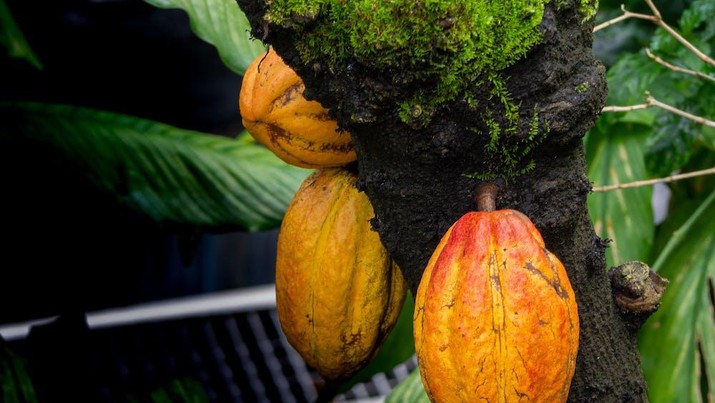The commodity cocoa, as the raw material for chocolate, is being hotly discussed in the world. Not without reason, this commodity is suspected to be the next feared victim of El Nino after rice and sugar. Even though this commodity is currently in trouble in Europe under the Deforestation Law.
Frequent extreme weather due to El Nino and climate change have a negative impact on cocoa production. Hotter temperatures and changes in rainfall patterns can also damage the development of cocoa pods and increase the spread of pests and diseases.
Based on the latest El Nino-Southern Oscillation Outlook,El Nino events in the world are expected to last until January to March 2024, with a 71% probability of increasing in November to January.
Danpak El Nino will become more intensive and occur frequently and can significantly reduce the amount of fertile land for cocoa cultivation. This not only threatens food security, but also endangers the livelihoods of farmers.
After rice and sugar, one of Indonesia’s mainstay commodities that has become a victim is cocoa, which is an important commodity for the world.
For your information, cocoa comes from the seeds of the cocoa tree and is an important ingredient in making chocolate. But it is not only used in food and confectionery. cocoa butter,By-products from cocoa processing are also widely used in the pharmaceutical industry for skin care products and cosmetics.
According to data from the International Cocoa Organization (ICCO), Indonesia is one of the ten cocoa producing countries in the world, in seventh place with production of 180 thousand tons in 2022.
The data shows that Africa accounts for almost 75% of global cocoa production, while the Americas include Brazil and Ecuadoraccounts for 20%, according to the International Cocoa Organization. Asia-Pacific produces the remaining 5%, with Indonesia and Papua New Guinea being the largest producers in the region.
For your information, Ivory Coast in West Africa is also the world’s largest cocoa producer, contributing around 44% of global production, while neighboring Ghana contributes around 14%.
The potential of Indonesian cocoa is no joke
Cocoa is one of the main plantation commodities whose role is quite important for the national economy, especially as a provider of employment opportunities, a source of income and foreign exchange for the country.
Apart from that, cocoa also plays a role in encouraging regional development and agro-industry development. In 2002, cocoa plantations provided employment and a source of income for around 900 thousand heads of farming families, most of whom were in the Eastern Region of Indonesia (KTI) and provided the largest foreign exchange contribution to the three plantation sub-sectors after rubber and palm oil with a value of US$ 701 million or around Rp. 11.02 trillion.
Cocoa plantations in Indonesia have experienced rapid development in the last 20 years and in 2002 the area of Indonesian cocoa plantations was recorded at 914,051 hectares.
According to business status in the last 10 years (2012-2021), cocoa plantations are mostly managed by community plantations (97.57%), 1.01% are managed by large state plantations (PBN) and the remaining 1.42% are managed by large private plantations. (PBS).
Based on BPS data, cocoa production in Indonesia will be 667,300 tonnes in 2022. This amount is 3.04% lower than in the previous year which reached 688,200 tonnes.
Looking at the trend, production of the commodity which is the raw material for chocolate has experienced a downward trend since 2019 until now. One of the reasons for this condition is that many cocoa trees are old, so they are no longer productive. Meanwhile, Central Sulawesi is the province that produces the most cocoa. The amount was recorded at 126,000 tons last year.
The development of Indonesian cocoa production in the 2013-2022 period also fluctuated with average growth increasing slightly by 0.96% per year. In 2013, Indonesian cocoa production was 721 thousand tons, then in 2022 (the Directorate General of Plantations estimates) it will be 732 thousand tons.
From the results of the Directorate General of Plantations’ estimates, cocoa production in 2022 (732 thousand tons) will increase by 3.63% compared to 2021 (707 thousand tons). The highest production during the 2012-2021 period occurred in 2018, namely 767.28 thousand tons.
The processed product from cocoa in the form of chocolate is liked by almost everyone of all ages and social status. The high consumption of chocolate is also based on the fact that chocolate is beneficial for human health. One of them is reducing the risk of heart disease where chocolate, especially dark chocolate, contains flavonoids which are high in antioxidants to minimize the risk of heart disease.
Based on average cocoa production data for the last five years (2016-2020), there are nine cocoa production center provinces in Indonesia which contribute up to 86.75%.
However, despite this potential, unfortunately Indonesia’s cocoa export volume in the last 10 years has had a downward trend with an average of -0.39% per year. The highest cocoa export volume was in 2013 (414 thousand tons) and the lowest volume was in 2016 (330 thousand tons).
Indonesia’s cocoa import volume is nominally lower than its export volume, but has a very significant upward trend, reaching 29.70% every year.
In 2011-2020, the average growth in cocoa export value was negative at -0.25% per year. The highest cocoa export value was achieved in 2011 at US$ 1.35 billion. Meanwhile, the growth in the value of cocoa imports in the same period was much higher, reaching 21.45% per year, with the highest cocoa import value occurring in 2019 at US$ 776 million.
Lastly, what you should know is that the destination countries for Indonesian cocoa exports are spread across the Americas, Europe and Asia.
The main destination country for Indonesian cocoa exports is Malaysia with an average export volume of 124 thousand tons (31.20%) during 2016-2020. followed by the United States (14.84%), India (5.96%), and China (5.53%). Other export destination countries with a market share of less than 5% are the Netherlands, the Philippines, Germany, Australia, Brazil.
According to the Ministry of Agriculture, other markets that are still wide open for market penetration for processed cocoa commodities are countries on the African continent such as Egypt which have an interest in cocoa powder from Indonesia.
Despite this, Indonesian cocoa agribusiness still faces various complex problems, including low plantation productivity due to attacks by cocoa pod borer (PBK), product quality is still low and the development of downstream cocoa products is still not optimal.
This is both a challenge and an opportunity for investors to develop their business and achieve greater added value from cocoa agribusiness. Plus, El Nino conditions are certainly haunting this industry.
Watch out! El Nino Can Cause Losses to Farmers and Business Actors
As temperatures rise, more suitable cocoa cultivation areas will increase by 2050, according to Climate.gov, a climate change science and information portal run by the National Oceanic and Atmospheric Administration.
As the optimal altitude for cocoa cultivation increases, cocoa farmers may be forced to move crops to higher elevations.
“Cocoa farmers facing important decisions may start looking for higher altitude areas where the weather is more favorable for cocoa cultivation, or some may decide to abandon cocoa cultivation altogether,” Kerry Daroci, cocoa sector leader at the Rainforest Alliance, was quoted as saying by CNBC International .
The financial costs of climate change could be devastating, especially as leading cocoa producers such as Ivory Coast, Ghana and Indonesia, are vulnerable to extreme weather conditions.
According to the Economist Intelligence Unit report, a high-intensity El Nino could cause severe economic disruption in all affected countries. Business actors in the agricultural sector are also at risk of experiencing increases in the price of agricultural raw materials which can increase overhead costs.
The financial losses due to El Niño and climate change are still incalculable in Ivory Coast and Ghana. However, since profits from cocoa account for 70% to 100% of the income of cocoa producers in Ghana, a decline in yields will have a major impact on their livelihoods, said Daroci of the Rainforest Alliance.
Manufacturers in West Africa are not the only ones affected. In Indonesia, climate change reduces productivity by around 50%, causing losses of around US$ 666 per hectare, and affecting one million hectares.
Today, cocoa prices have soared to a “high premium,” according to the International Cocoa Organization.
At the end of August, cocoa futures prices closed at US$ 3,730 per ton in London, and US$ 3,633 per ton in New York, according to the latest ICCO data. This figure represents a jump of 78% from US$ 2,095 per ton in London last year and an increase of almost 50% compared to last year from US$ 2,427 per ton in New York.
“This represents the highest possible contract price for the 2022/23 season,” the report said.
Cocoa prices are at their highest point in 50 years, according to a Reuters report. Cocoa prices have soared in the past year and even set a 44-year high on September 13, 2023. The cocoa harvest in Ivory Coast failed due to climate change.
Tropical Research Services estimates that 20% of the cocoa crop in Ivory Coast is infected with the virus. Ghanaian production is also flying as their production is falling.
If production from Indonesia is threatened due to El Nino, then the importing country will suffer the impact. The value of cocoa imports to the European Union in 2022 was recorded at US$ 7.41 billion.
Even though it has decreased compared to the previous year, this figure is still the largest of other countries. The high level of chocolate consumption among European people is certainly an attraction for Indonesian cocoa producers and exporters.
There are all cocoa processing industries in Indonesia. The biggest chocolate factories in the world are in Indonesia, Mars, Cargill, Nestle are in Indonesia. If they are affected, it is on their own.
In the following list there are 10 chocolate companies with the largest sales in the world based on data released in 2022. With this data, are there any multinational companies that involve the European Union?
Just look, Lindt & Sprungli AG is the company with the largest chocolate sales reaching US$ 4.6 billion. A Swiss confectionery company founded in 1845 and known for its chocolate truffles and chocolate bars, among other candies.
Apart from that, the name Nestle SA is also entrenched, which is the largest food and beverage manufacturing company in the world, headquartered in Vevey, Switzerland and has been operating for 150 years. He is also established in Indonesia and his name is certainly familiar to the ears of the Indonesian people.
Market players tend to wait and see regarding the impact of El Nino on the cocoa industry. However, if undesirable things happen, cocoa prices are predicted to soar.
Source : CNBC















